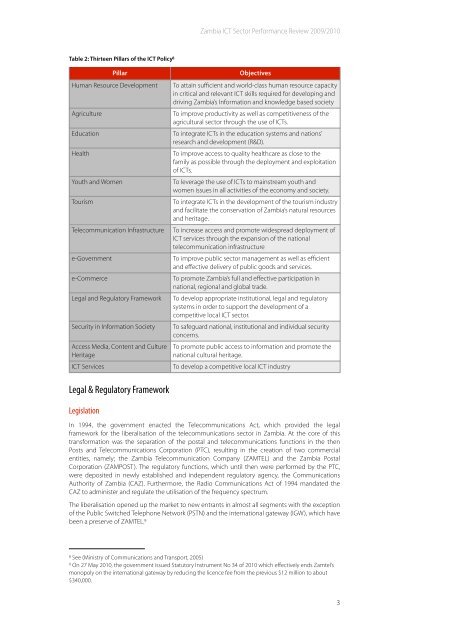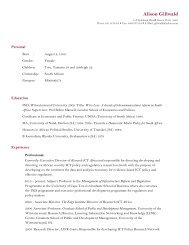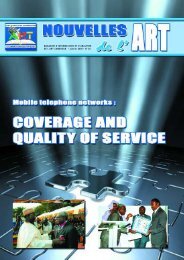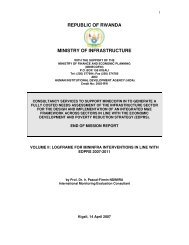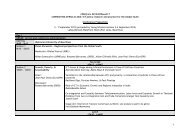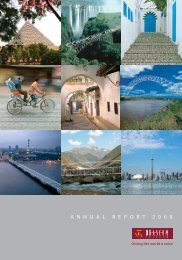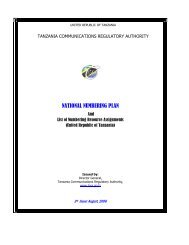Zambia ICT Sector Performance Review 2010 - Research ICT Africa
Zambia ICT Sector Performance Review 2010 - Research ICT Africa
Zambia ICT Sector Performance Review 2010 - Research ICT Africa
Create successful ePaper yourself
Turn your PDF publications into a flip-book with our unique Google optimized e-Paper software.
<strong>Zambia</strong> <strong>ICT</strong> <strong>Sector</strong> <strong>Performance</strong> <strong>Review</strong> 2009/<strong>2010</strong><br />
Table 2: Thirteen Pillars of the <strong>ICT</strong> Policy 8<br />
Pillar<br />
Objectives<br />
Human Resource Development To attain sufficient and world-class human resource capacity<br />
in critical and relevant <strong>ICT</strong> skills required for developing and<br />
driving <strong>Zambia</strong>’s Information and knowledge based society<br />
Agriculture<br />
To improve productivity as well as competitiveness of the<br />
agricultural sector through the use of <strong>ICT</strong>s.<br />
Education<br />
To integrate <strong>ICT</strong>s in the education systems and nations’<br />
research and development (R&D).<br />
Health<br />
To improve access to quality healthcare as close to the<br />
family as possible through the deployment and exploitation<br />
of <strong>ICT</strong>s.<br />
Youth and Women<br />
To leverage the use of <strong>ICT</strong>s to mainstream youth and<br />
women issues in all activities of the economy and society.<br />
Tourism<br />
To integrate <strong>ICT</strong>s in the development of the tourism industry<br />
and facilitate the conservation of <strong>Zambia</strong>’s natural resources<br />
and heritage.<br />
Telecommunication Infrastructure To increase access and promote widespread deployment of<br />
<strong>ICT</strong> services through the expansion of the national<br />
telecommunication infrastructure<br />
e-Government<br />
To improve public sector management as well as efficient<br />
and effective delivery of public goods and services.<br />
e-Commerce<br />
To promote <strong>Zambia</strong>’s full and effective participation in<br />
national, regional and global trade.<br />
Legal and Regulatory Framework To develop appropriate institutional, legal and regulatory<br />
systems in order to support the development of a<br />
competitive local <strong>ICT</strong> sector.<br />
Security in Information Society To safeguard national, institutional and individual security<br />
concerns.<br />
Access Media, Content and Culture To promote public access to information and promote the<br />
Heritage<br />
national cultural heritage.<br />
<strong>ICT</strong> Services<br />
To develop a competitive local <strong>ICT</strong> industry<br />
Legal & Regulatory Framework<br />
Legislation<br />
In 1994, the government enacted the Telecommunications Act, which provided the legal<br />
framework for the liberalisation of the telecommunications sector in <strong>Zambia</strong>. At the core of this<br />
transformation was the separation of the postal and telecommunications functions in the then<br />
Posts and Telecommunications Corporation (PTC), resulting in the creation of two commercial<br />
entities, namely; the <strong>Zambia</strong> Telecommunication Company (ZAMTEL) and the <strong>Zambia</strong> Postal<br />
Corporation (ZAMPOST). The regulatory functions, which until then were performed by the PTC,<br />
were deposited in newly established and independent regulatory agency, the Communications<br />
Authority of <strong>Zambia</strong> (CAZ). Furthermore, the Radio Communications Act of 1994 mandated the<br />
CAZ to administer and regulate the utilisation of the frequency spectrum.<br />
The liberalisation opened up the market to new entrants in almost all segments with the exception<br />
of the Public Switched Telephone Network (PSTN) and the international gateway (IGW), which have<br />
been a preserve of ZAMTEL. 9<br />
8 See (Ministry of Communications and Transport, 2005)<br />
9 On 27 May <strong>2010</strong>, the government issued Statutory Instrument No 34 of <strong>2010</strong> which effectively ends Zamtel’s<br />
monopoly on the international gateway by reducing the licence fee from the previous $12 million to about<br />
$340,000.<br />
3


